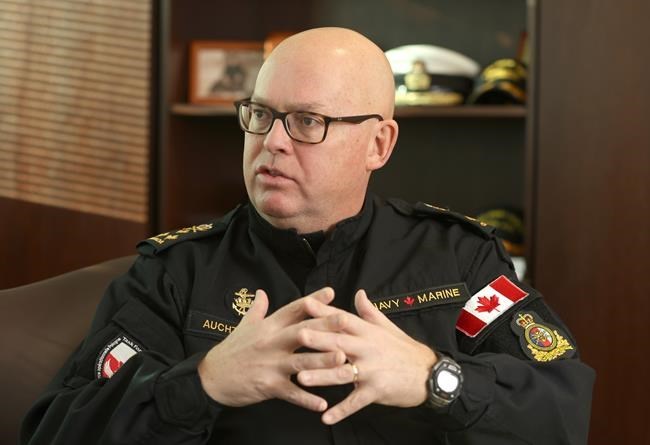OTTAWA — The Canadian Armed Forces is shrinking its footprint in Iraq and the Middle East to free up troops for deployment to Europe and elsewhere, as a personnel shortage and growing demands at home and abroad test the military's limits.
In an interview with The Canadian Press, Vice-Admiral Bob Auchterlonie, head of the Canadian Joint Operations Command that runs all Canadian military operations at home and abroad, said the Armed Forces will continue to have a presence in the Middle East.
That includes maintaining a logistical hub in Kuwait and small training missions in Jordan, Lebanon and Iraq.
Auchterlonie said the Middle East is one of the few areas where he has flexibility as he juggles Canada's numerous other commitments with the military's limited resources — especially people.
"Given the importance of the conflict in Ukraine, obviously we're going continue to support that," he said. "The commitments to NATO — obviously, we're going to continue to support that. And with the increase in the Indo-Pacific, there's not a lot of room left to reduce."
Thousands of Canadian troops have deployed to the Middle East since 2014, when Canada joined its allies in declaring war on the Islamic State of Iraq and the Levant, which at the time had captured large swaths of Iraq and Syria.
Known as Operation Impact, Canada's contribution included fighter jets, transport and surveillance aircraft, special forces soldiers and helicopters, a medical hospital and hundreds of military trainers working with Iraqi, Jordanian and Lebanese soldiers.
At the operation's height, about 800 Canadian troops were deployed to the region, making it Canada's largest mission since Afghanistan.
The Canadian Armed Forces started shrinking its presence following ISIL's defeat in Iraq in 2017.
The decline was further hastened by the COVID-19 pandemic, growing tensions with Iran and political turmoil in Baghdad before Russia's invasion of Ukraine put European security front and centre, sparking new demands for the Canadian military.
Auchterlonie revealed that the Liberal government has set a cap of 450 Armed Forces members for Op Impact, though only about 250 are currently involved in the mission. Even that number is set to decline further to meet other demands.
"We're looking at scoping that down to allow ... specifically the Army more folks to move elsewhere," he said. "So we've reduced that mission in terms of numbers, and I've reduced the skill sets and requirements of people deployed to free up other people in the Army."
In an interview in December, Canadian Army commander Lt.-Gen. Joe Paul said his force was being squeezed by more demands at home and abroad, especially in Europe, even as the number of soldiers available for such missions is shrinking.
Paul told The Canadian Press that the Army shrunk by 1,200 soldiers last year as departures outpaced recruiting — and that it could lose hundreds more unless the situation changes. The whole military is short about 10,000 members, meaning one in 10 positions is vacant.
This shortage comes as Canada has doubled the number of military trainers working with Ukrainian counterparts from 200 to 400 following Russia's invasion. The Army is also poised to reinforce a Canadian-led NATO battle group in Latvia, which will require hundreds more troops.
All of that coincides with the military being asked to respond more and more natural disasters at home.
To illustrate the impact on Canadian troops, Auchterlonie pointed to one unit in August 2021 that was helping with flood relief efforts in the Yukon when it was sent to Kuwait to help with the Afghanistan evacuation — and then got deployed to Ukraine to train local forces.
There are also the military's challenges in terms of equipment, due to its limited number of old ships and aircraft and gaps such as a lack of anti-air defence capability.
And the government recently announced a plan to increase the Armed Forces' presence in the Indo-Pacific region.
"So demand is up ... and trying to meet that is really challenging," Auchterlonie said. "Therefore, in missions that I have scope to reduce, I have."
This report by The Canadian Press was first published Jan. 19, 2023.
Lee Berthiaume, The Canadian Press

